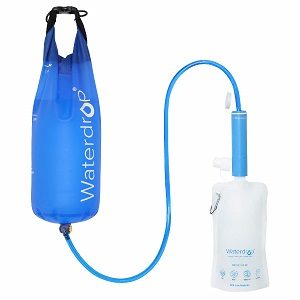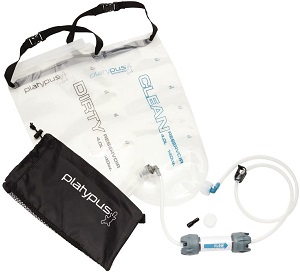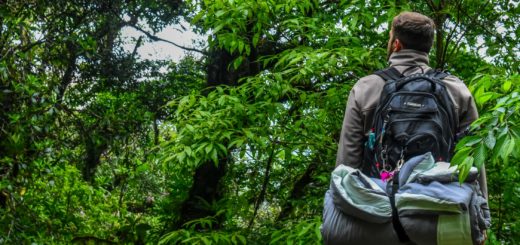How to Turn Seawater into Drinking Water for Survival
by Ryan W ·
This page may contain affiliate links. For more information, see our "About Us" page.
Turn Seawater into Drinkable Water for Survival

When planning a backpacking, hiking, or camping trip, the last thing on most people’s minds is survival. “Meeting basic human needs for a few days shouldn’t be difficult” – sounds familiar right? Without thinking, you toss together a backpack, cooler, and other essentials then go about your merry way. In most situations this mindset will suffice, well, until it doesn’t. Sometimes Mother Nature isn’t playing around, in which case you need to plan for the unexpected. Staying hydrated should always be a top priority, and knowing how to turn seawater into drinking water for a survival situation is a must. Today we’re digging deep to find the best gravity fed water filter for backpacking to ensure a supply of fresh drinkable water anywhere, anytime.
What is a Gravity Fed Water Filter?
As you might suspect, a gravity fed water filter functions with help from the forces of gravity. In a nutshell, these are devices usually consisting of two separate chambers (though sometimes more) stacked on top of one another. The dirty and contaminated water is poured into the upper chamber, and gradually gravity will push it through the different layers until the filtering process is complete. Gravity fed water filters are ideal for backpacking, camping, hiking, and even an off-grid lifestyle due to their ability to function without the need for electricity.
What is the Best Gravity Water Filter System?
When it comes to finding the best of the best, there is no one size fits all. While you could, in theory, use the same (smaller) device in all situations, one might prefer a larger system for home and/or RV use. In this article, however, we’ll be focusing on smaller models able to fit within the confines of an average-sized backpacking or hiking backpack. Without further ado, let’s get into it!
#1 – Waterdrop Personal Water Filter Straw with Gravity Water Bag ($30-$35)
Starting with the cheapest workable option, we have the Waterdrop Personal Water Filter Straw with Gravity Water Bag. This setup combines a 4-stage filtration system ensuring your water exits clean and safe to drink. Stage one consists of a pre-filter fabric which aids in the removal of bigger particles such as stones, leaves, and dirt. The second stage uses a hollow fiber membrane to capture 99.99% of bacteria. Third you’ll find an activated carbon fiber filter (originated from coconut shell), which helps to improve the smell and taste of the purified water. Finally, the fourth stage is a post polyester membrane, that makes sure your water is free from rust, sediment, and particulates. The Waterdrop is an excellent starter option that doesn’t break the bank!
#2 – LifeStraw Flex Advanced Water Filter with Gravity Bag ($45-$55)
If you’ve ever looked at filtering water when out and about, LifeStraw is probably a brand you’ve heard mentioned many times. Featuring a hollow fiber membrane coming in at 0.2 micron pore size, the LifeStraw Flex Advanced Water Filter with Gravity Bag is able to remove up to 99.999999% of bacteria, protozoa, and micro plastics. Not only does the LifeStraw exceed US EPA drinking water standards for both parasites AND bacteria, but also NSF 53 standards for lead and other heavy metals. It also boasts a longer longevity than most other filters, at around 2,000 liters for the hollow fiber membrane, and 100 liters for the replaceable carbon capsule. As if that weren’t enough, LifeStraw also claims that for every straw purchased, a school child in need will receive safe drinking water for an entire school year. I’d call that a win/win for everyone!
#3 – Platypus GravityWorks High-Capacity Water Filter System ($110-$120)
Coming in last on our list of filters is the Platypus GravityWorks High-Capacity Water Filter System. While nearly double the price of the LifeStraw, the Platypus makes up for it in multiple ways. For example, it features a high-capacity – able to hold 4-liters of both dirty and clean water. Moving on, it meets all EPA/NSF guidelines for removal of up to 99.9999% of bacteria, and protozoa including giardia, cryptosporidium, E. coli, salmonella, and cholera. Plus, with a flow rate of 1.75 liters/minute, fresh water is available in a snap. Incredibly enough, the entire kit fits neatly into the included storage sack and weighs only 11.5 ounces, not to mention it’s made in the USA!
How to Turn Seawater into Drinking Water for Survival – Conclusion
As you can see, there are a number of options available when considering the best gravity fed water filter for backpacking. While all of the filters on this list do a fine job at filtering your water, only you can choose the perfect fit based on deciding factors like budget, weight, and space requirements. No matter which you choose, we promise you won’t be disappointed. Knowing how to turn seawater into drinking water for survival situations is an absolute must. For more backpacking related tools and accessories, check out our Gear Lists section! Safe and happy travels!






